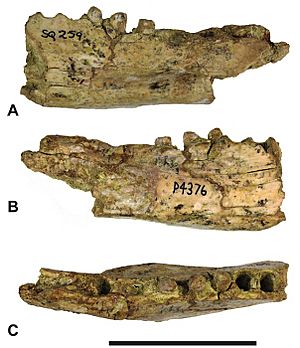Thylacinus megiriani facts for kids
Quick facts for kids Thylacinus megiriani |
|
|---|---|
 |
|
| Dentary | |
| Scientific classification |
The Thylacinus megiriani was an ancient animal that lived about 8 million years ago. This was during a time called the late Miocene period. It lived in an area of the Northern Territory in Australia. This place was once a forest with plenty of water.
This animal was a marsupial predator, meaning it was a meat-eater with a pouch. It walked on four legs and looked a lot like a dog. It had a long snout. Its teeth were special for eating meat. They were very large compared to its body. Scientists think it weighed more than 57 kilograms (about 125 pounds).
Thylacinus megiriani was one of the top predators in its habitat. It shared its hunting grounds with large crocodiles and giant monitor lizards. These animals were likely the main hunters in the Alcoota area.
Scientists have found fossils of Thylacinus megiriani in Alcoota. They have also found fossils of another ancient thylacine, T. potens, there. These fossils are quite rare. Some fossil groups show many animals died close together. This might have happened because of droughts or bad weather.
Discovering This Ancient Hunter
Scientists first described Thylacinus megiriani in 1997. The paleontologist Peter F. Murray published the first study about it.
The first fossil was found in the Alcoota fossil area. A geologist named Dirk Megirian found it. He worked very carefully to dig out the fossil. Because of his hard work, the animal was named megiriani in his honor.
What Did It Look Like?
Thylacinus megiriani was a type of Thylacinus, which includes the more recent Tasmanian tiger. This ancient species was a bit bigger than the Tasmanian tiger (Thylacinus cynocephalus).
It weighed about the same as another ancient thylacine, Thylacinus potens. Both of these animals likely weighed between 38.7 and 57.3 kilograms.
The fossils found in Alcoota were very broken. Scientists had to carefully put together parts of its jaw to study it. The first ideas of what it looked like were later changed by the scientist who described it.
Scientists now believe Thylacinus megiriani had stronger teeth and a bigger mouth than the Tasmanian tiger. But it had a more slender and longer snout, similar to the Tasmanian tiger, rather than the shorter snout of T. potens.

